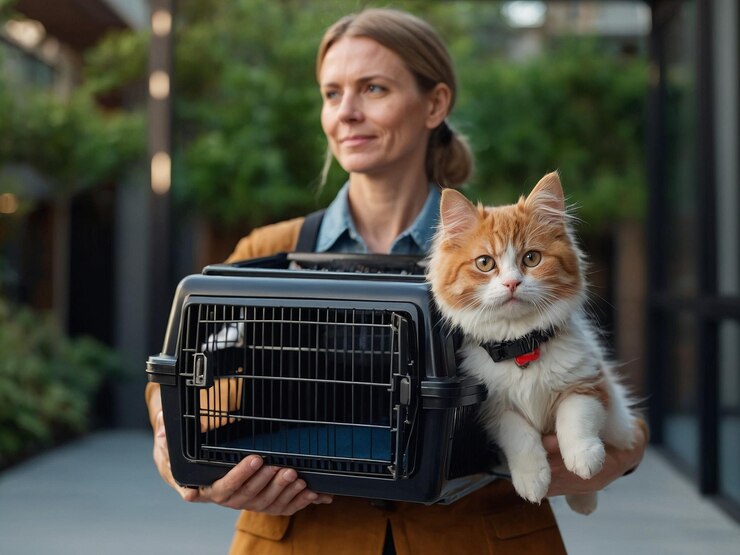Choosing a suitable cat carrier is essential for your feline friend’s comfort and safety, whether you’re heading to the vet or embarking on a long trip. The appropriate carrier makes the journey smoother and ensures your cat feels secure and at ease.
This guide will help you navigate the various options and find the best cat carrier that fits your needs and your cat’s unique personality.
Understanding Your Cat’s Needs
Before picking a cat carrier, it’s crucial to consider your cat’s personality, size, and specific needs. Cats, like humans, have individual preferences. Some are adventurous and curious, while others may be shy and anxious. These traits will influence the type of carrier that will work best for them.
A calm cat may be content in a soft-sided carrier, while a more nervous feline might prefer the sturdiness of a hard-sided pet carrier. It’s essential to observe your cat’s behavior to understand what type of environment makes them feel most secure.
Size and Space: Ensuring a Comfortable Fit
When selecting a cat carrier, size is a critical factor that directly impacts your cat’s comfort and stress levels. A carrier that is too small or too large can lead to unnecessary discomfort, so choosing the right size is essential. To find the perfect fit, measure your cat from the tip of its nose to the base of its tail and from the floor to the top of its head.
In “How to Choose the Perfect Cat Carrier: A Guide for Pet Owners,” the ideal carrier should allow your cat to sit, stand, and turn around comfortably. Ensuring the right dimensions for your cat’s carrier is crucial for long journeys, as it helps keep your feline friend at ease throughout the trip.
Material Matters: Durability and Ventilation
The material of the carrier plays a significant role in its durability, ventilation, and ease of cleaning. Cat carriers come in various materials, such as plastic, fabric, and metal. Plastic carriers are durable and easy to clean, making them ideal for regular use. Fabric carriers, on the other hand, offer better ventilation and are more lightweight, but they may not be as sturdy. Metal carriers are highly durable but can be heavier and less comfortable for your cat.
When selecting a material, consider how easy it is to maintain and whether it provides adequate airflow to keep your cat cool and comfortable.
Types of Cat Carriers: Pros and Cons
There are a few types of cat carriers:
Hard-Sided Carriers
- Pros:
Durability: These carriers are sturdy and provide excellent protection during travel, making them ideal for long or air trips.
Easy to Clean: The hard surfaces are easy to wipe down, which is especially helpful if your cat has an accident.
- Cons:
Heavier: Hard-sided carriers are generally heavier, making them more challenging to carry.
Less Comfortable: The rigid structure may not be as comfortable for your cat during extended travel.
Soft-Sided Carriers
- Pros:
Lightweight: These carriers are more accessible to carry and are often more comfortable for you and your cat.
Flexible: The soft sides can be more comfortable for your cat, especially on short trips.
- Cons:
Less Protection: While soft-sided carriers are cozy, they offer less protection, making them less ideal for air travel or long trips.
More Difficult to Clean: The fabric can absorb odors and stains, requiring more cleaning effort.
Backpack Carriers
- Pros:
Hands-Free: Backpack carriers allow you to keep your hands free, making them perfect for hikes or city strolls.
Good Visibility: Many backpacks have mesh windows, allowing your cat to look around and enjoy the view.
- Cons:
Limited Space: Backpack carriers are typically smaller, which might not be comfortable for more giant cats.
Less Ventilation: Depending on the design, some backpacks may have limited ventilation, which could make your cat uncomfortable during longer trips.
Safety Features to Look For
Safety should be your top priority when selecting a cat carrier, so look for features that keep your cat secure. Essential safety features include secure latches that prevent accidental openings, sturdy handles that make carrying the carrier easier, and proper ventilation to ensure your cat gets enough air during the trip. Additionally, look for carriers with interior padding or the option to add a blanket to keep your cat comfortable and reduce the risk of injury during travel.
Ease of Use for Pet Parents
A carrier that’s easy to use will make your life much more straightforward, especially during stressful moments like vet visits. Consider choosing a cat carrier that is easy to load and unload, with wide openings or removable tops that make it less stressful for your cat to enter and exit.
Lightweight carriers are also easier to handle, especially if you’re carrying your cat for long distances. User-friendly designs, such as carriers with multiple access points or built-in storage pockets, can significantly improve your overall experience.
Comfort Enhancements for a Smooth Ride
Adding a few comfort features to the carrier can significantly improve your cat’s travel experience. Soft bedding, for example, can provide extra cushioning and make the carrier more inviting. Familiar scents, like a blanket from home, can help soothe your cat’s nerves. You might also consider using calming aids, such as pheromone sprays or herbal supplements, to reduce anxiety during the trip.
These enhancements can turn a potentially stressful journey into a more comfortable and peaceful experience for your cat.
Considering Portability and Storage
Portability is key when you’re on the go, so selecting a carrier that’s both lightweight and easy to store is essential. If you travel frequently or have limited space at home, look for foldable carriers or convenient storage options.
Portable cat carriers, especially those designed to be collapsible, offer the flexibility of easy storage when not in use, making them an excellent choice for pet parents with limited space.
Testing the Carrier Before Travel
Before hitting the road, it’s wise to introduce your cat to the carrier gradually to ensure they feel comfortable and secure. Start by leaving the carrier open in your home, allowing your cat to explore it at their own pace. Place treats, toys, or their favorite blanket inside to encourage positive associations.
You can also try short test trips around the block to familiarize your cat with the carrier and the car’s movement. This gradual introduction helps reduce stress and ensures a smoother travel experience.
Ready to find the perfect carrier for your cat? Discover how to choose the best cat carrier for your furry friend and make every trip a breeze!
Conclusion
Selecting the perfect cat carrier involves careful consideration of your cat’s needs, travel plans, and safety features to ensure a stress-free experience. By prioritizing comfort, safety, and ease of use, you’ll be better equipped to choose a carrier that makes every journey with your cat a pleasant one. Remember, a well-chosen cat carrier is not just a travel accessory—it’s a crucial tool for keeping your feline friend safe and comfortable, no matter where your adventures take you.
FAQs
What size cat carrier should I choose?
The suitable size carrier should allow your cat to sit, stand, turn around, and lie comfortably. Measure your cat from the tip of its nose to the base of its tail and from the floor to the top of its head. The carrier should be large enough to accommodate these dimensions but not too spacious, as too much room can make your cat insecure.
How do I know if a soft-sided or hard-sided carrier is better for my cat?
The choice between a soft-sided and hard-sided carrier depends on your cat’s temperament and travel needs. Soft-sided carriers are lightweight and flexible, ideal for calm cats and short trips. Hard-sided carriers offer more protection and are better suited for anxious cats or long journeys, including air travel.
What are the essential safety features to look for in a cat carrier?
Look for carriers with secure latches to prevent accidental openings, sturdy handles for safe carrying, and proper ventilation for airflow. Interior padding or adding a blanket is also essential to keep your cat comfortable and secure during travel.
How can I help my cat get used to a new carrier?
Introduce the carrier gradually by leaving it open in your home with treats, toys, or a familiar blanket inside. Allow your cat to explore it at their own pace. Taking short practice trips in the carrier can also help your cat adjust to the experience and reduce travel-related stress.
Can I use a backpack carrier for a large cat?
Backpack carriers are generally designed for smaller cats due to their limited space. If you have a large cat, ensure the backpack offers enough room for your cat to move comfortably and has sufficient ventilation. Always check the weight limit and dimensions of the backpack to ensure it’s suitable for your cat.
Stay tuned for more news and updates on Infinite Insight Hub!



